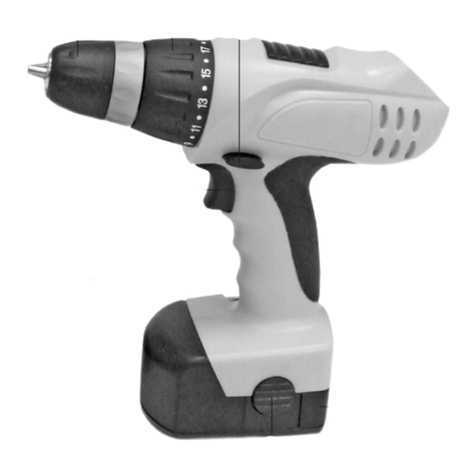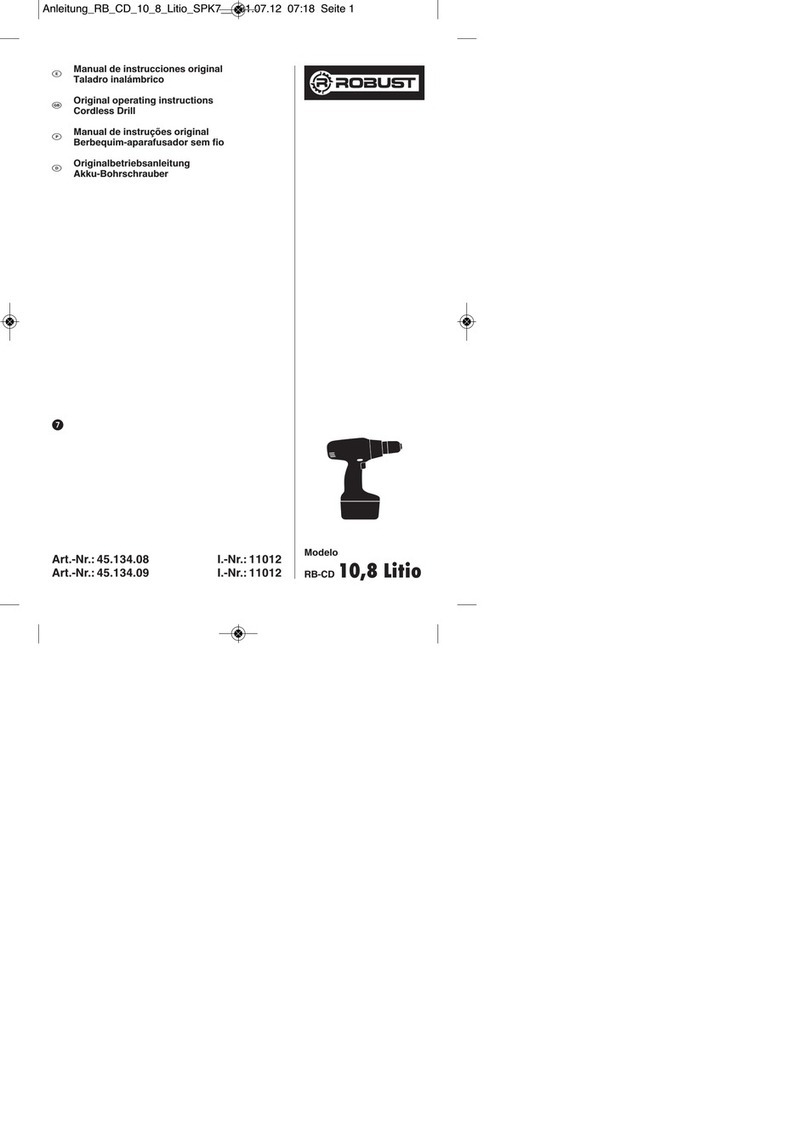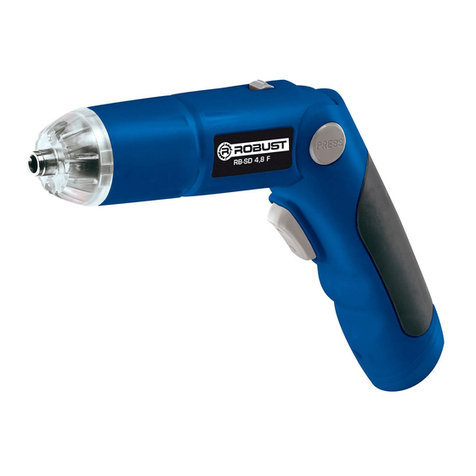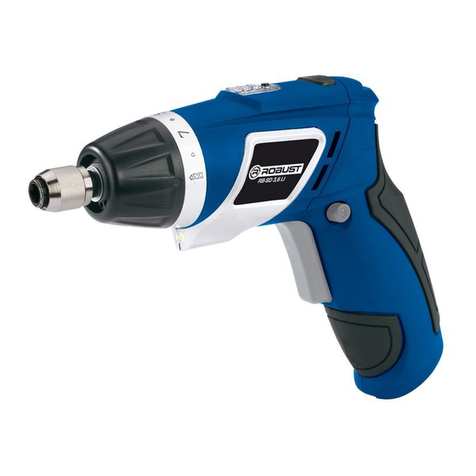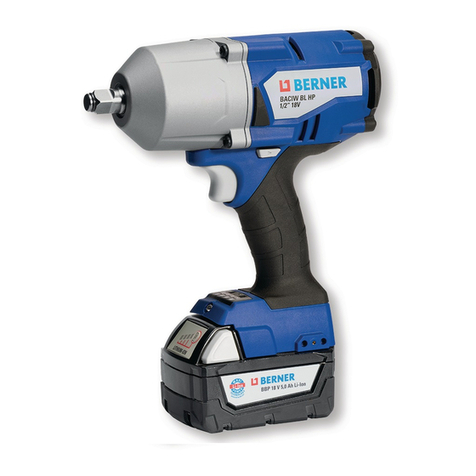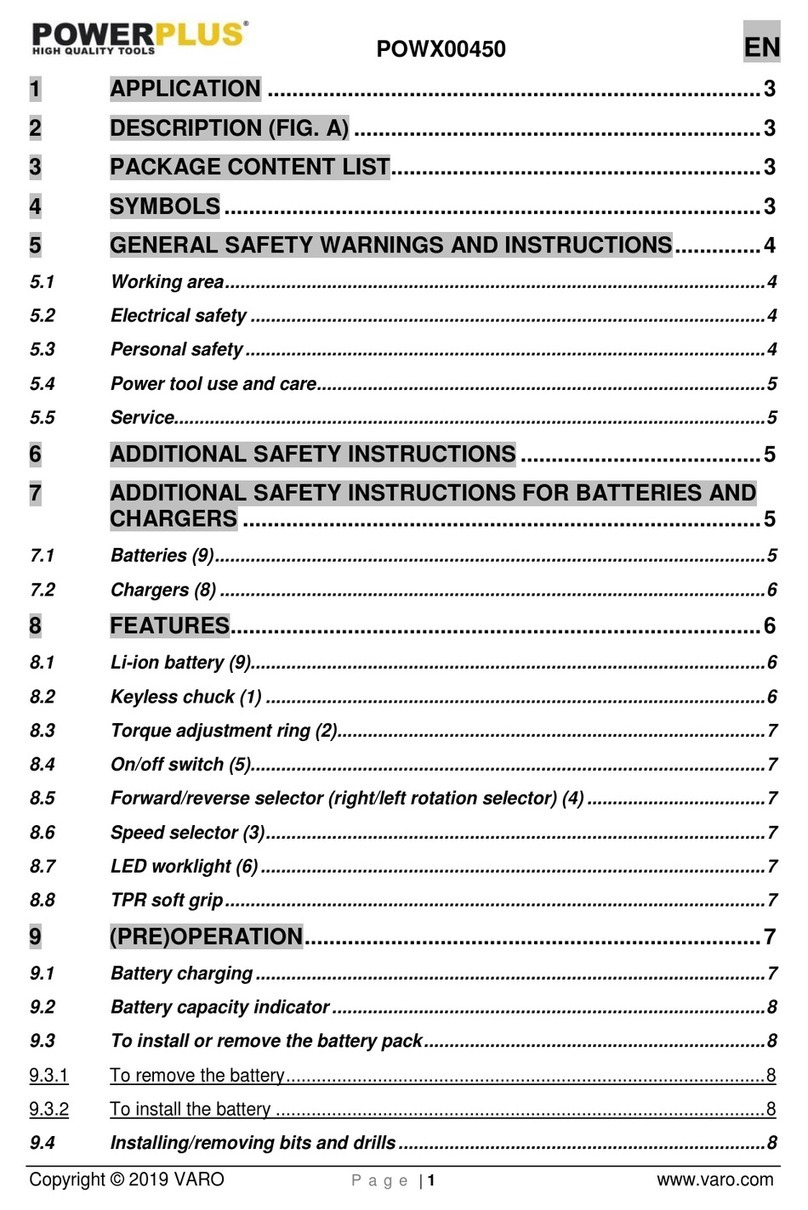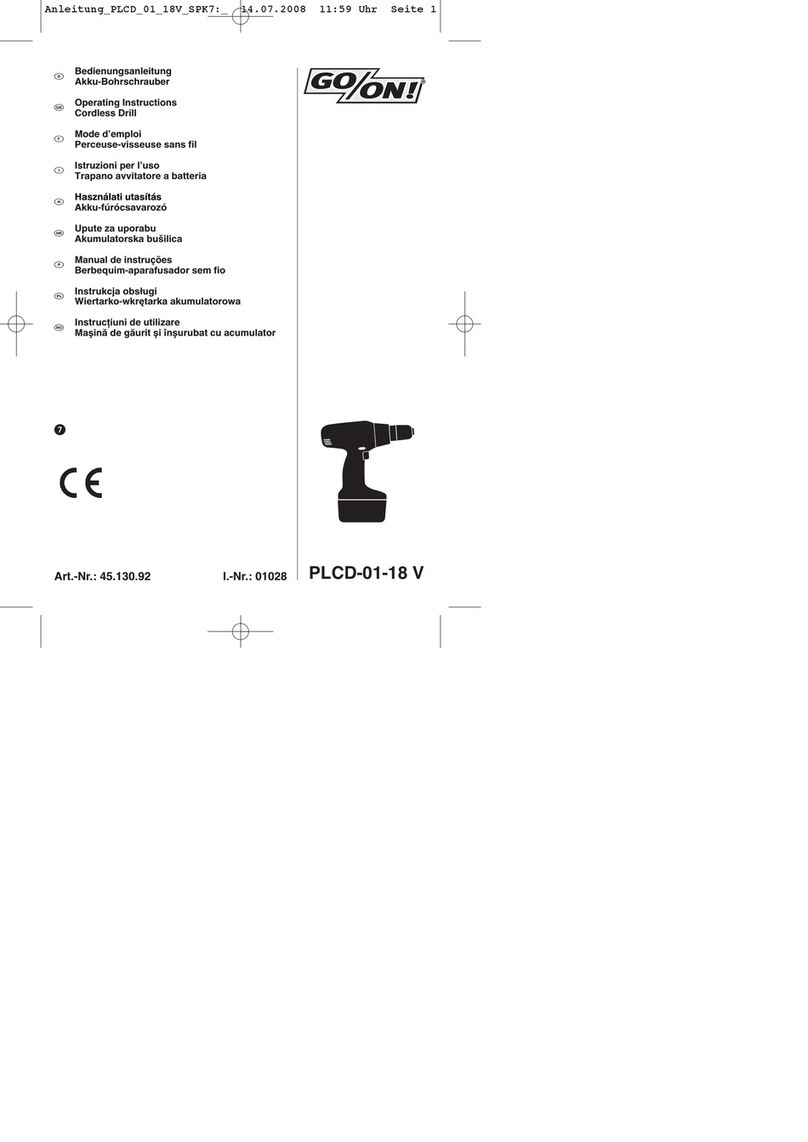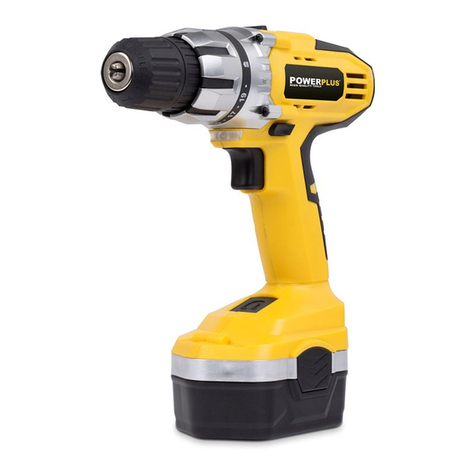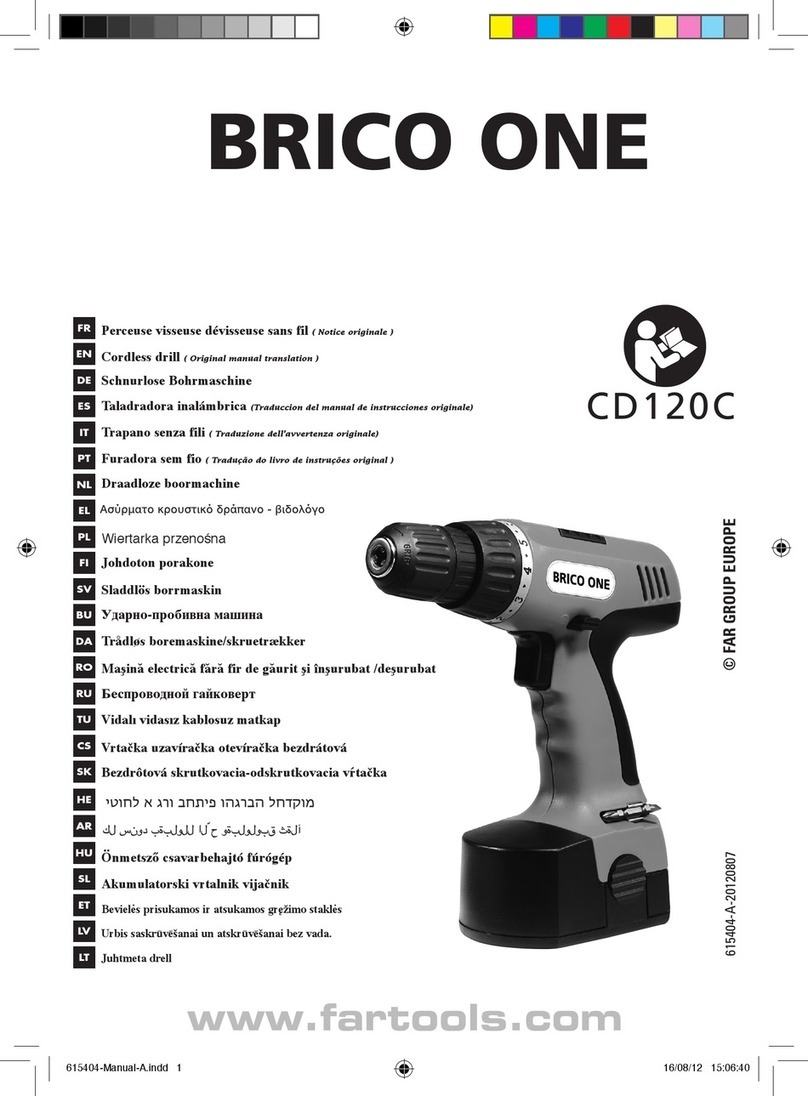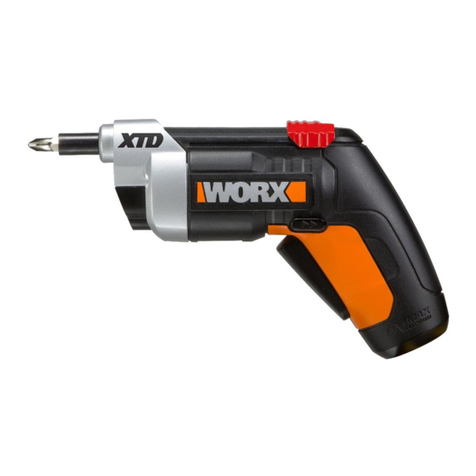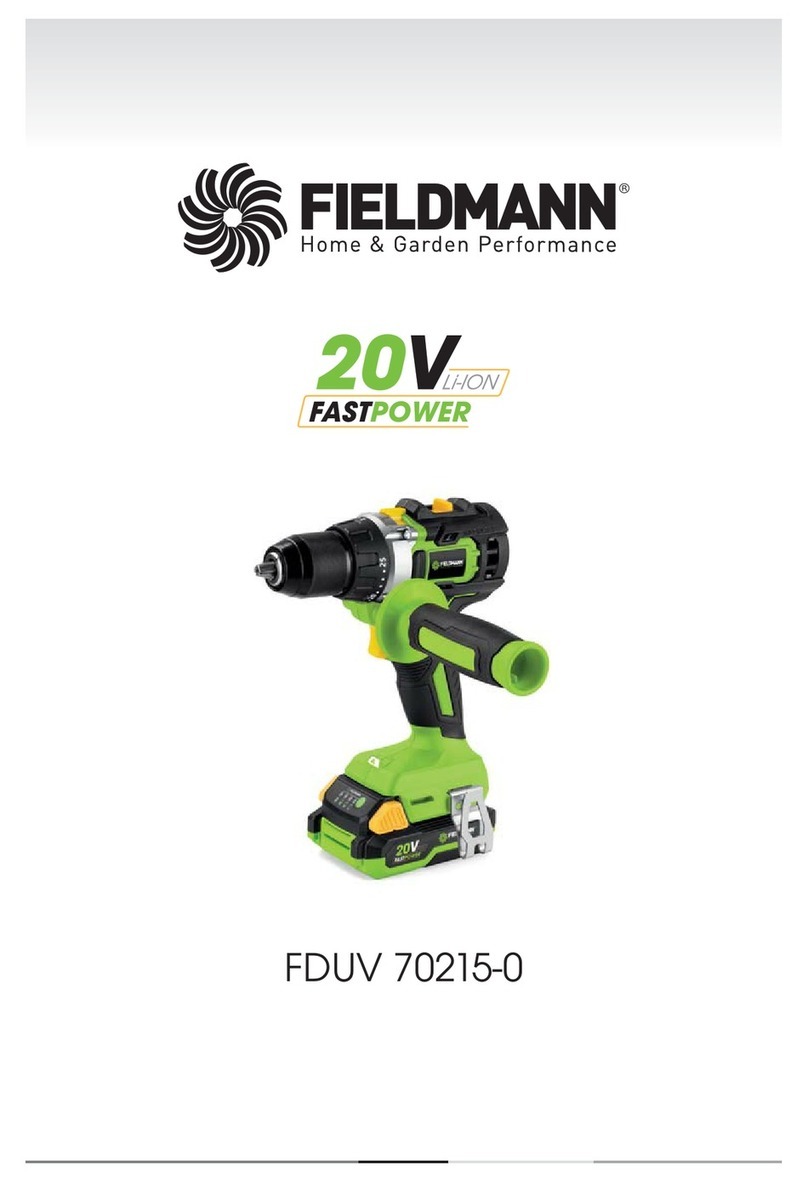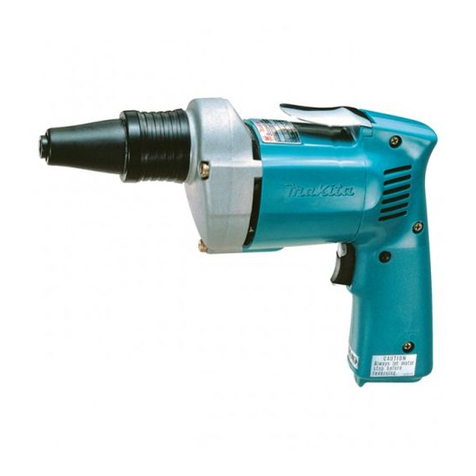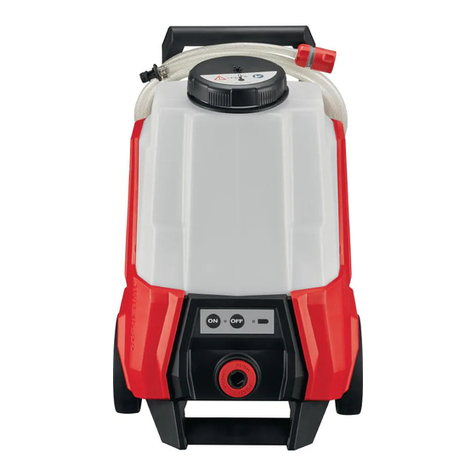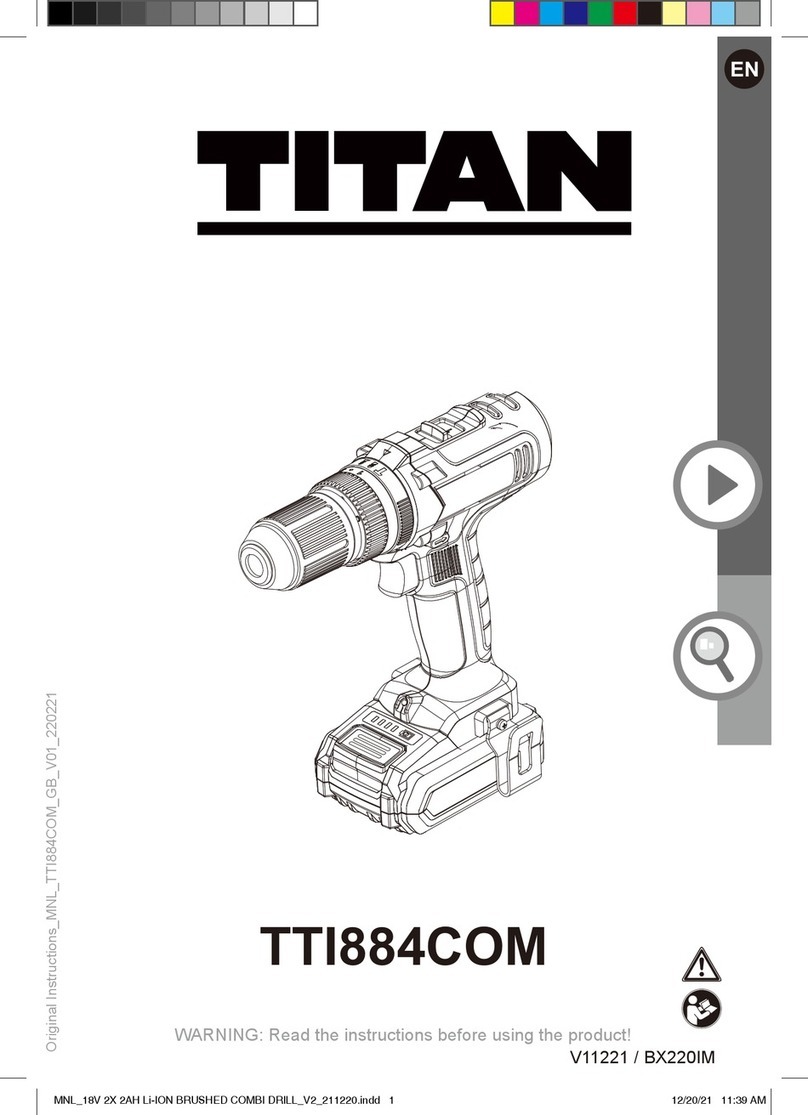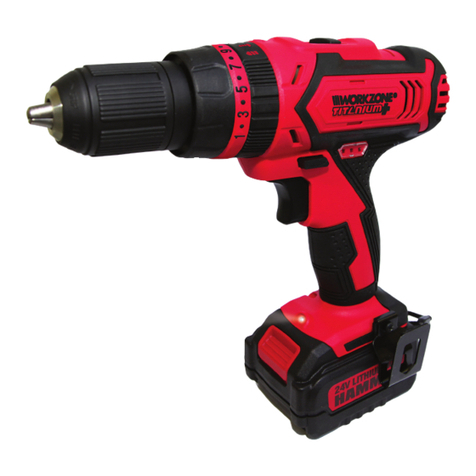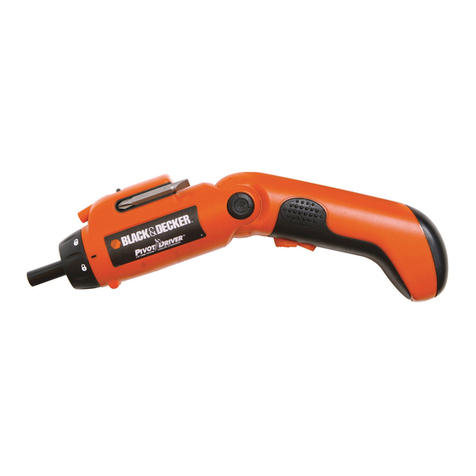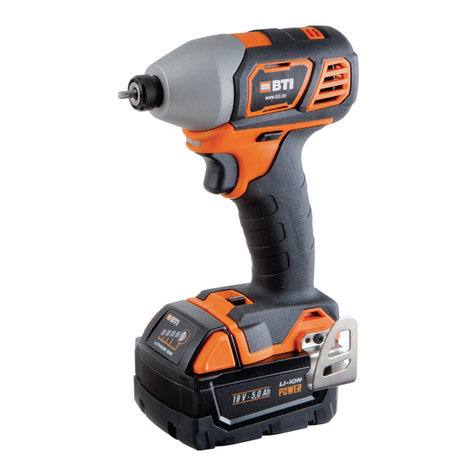Robust RB-CD 18 2B User manual

Art.-Nr.: 45.134.04 I.-Nr.: 11012
Art.-Nr.: 45.134.05 I.-Nr.: 11012
Modelo
RB-CD 18 2B
mManual de instrucciones original
Taladro inalámbrico
tOriginal operating instructions
Cordless Drill
OManual de instruções original
Berbequim-aparafusador sem fio
kOriginalbetriebsanleitung
Akku-Bohrschrauber
Anleitung_RB_CD_18_2_B_SPK7__ 02.08.12 14:41 Seite 1

2
1
213
7
6
8
2 3
5
4
1.
2.
5
6
8
1.
7
5
a
1.
2.
Anleitung_RB_CD_18_2_B_SPK7__ 02.08.12 14:42 Seite 2

3
4
1
5
4
6
a
3
2
Anleitung_RB_CD_18_2_B_SPK7__ 02.08.12 14:42 Seite 3

4
E
“Aviso - Leer el manual de instrucciones para reducir cualquier riesgo de sufrir daños”
Usar protección para los oídos.
La exposición al ruido puede ser perjudicial para el oído.
Es preciso ponerse una mascarilla de protección.
Puede generarse polvo dañino para la salud cuando se realicen trabajos en madera o en otros
materiales. ¡Está prohibido trabajar con material que contenga asbesto!
Llevar gafas de protección.
Durante el trabajo, la expulsión de chispas, astillas, virutas y polvo por el aparato pueden
provocar pérdida de vista.
Anleitung_RB_CD_18_2_B_SPK7__ 02.08.12 14:42 Seite 4

5
E
¡Atención!
Al usar aparatos es preciso tener en cuenta una
serie de medidas de seguridad para evitar lesiones o
daños. Por este motivo, es preciso leer atentamente
estas instrucciones de uso. Guardar esta
información cuidadosamente para poder consultarla
en cualquier momento. En caso de entregar el
aparato a terceras personas, será preciso
entregarles, asimismo, el manual de instrucciones.
No nos hacemos responsables de accidentes o
daños provocados por no tener en cuenta este
manual y las instrucciones de seguridad.
1. Instrucciones de seguridad
¡AVISO!
Lea todas las instrucciones de seguridad e
indicaciones.
El incumplimiento de dichas instrucciones e
indicaciones puede provocar descargas, incendios
y/o daños graves.
Guarde todas las instrucciones de seguridad e
indicaciones para posibles consultas
posteriores.
El término de “herramienta eléctrica” que se usa en
las instrucciones de seguridad se refiere a las
herramientas que funcionan en red (con cable de
conexión) y con batería (sin cable de conexión).
1. Seguridad en el lugar de trabajo
a) Mantener limpia y bien iluminada la zona de
trabajo. Las zonas de trabajo desordenadas o
sin luz pueden conllevar accidentes.
b) No trabajar con este aparato eléctrico en un
entorno explosivo en el que se hallen
líquidos, gases o polvos inflamables. Las
herramientas eléctricas generan chispas que
pueden inflamar el polvo o los vapores.
c) Mantener alejados a niños y a otras personas
fuera del alcance de la herramienta eléctrica.
Las distracciones pueden hacer perder el control
sobre el aparato.
2. Seguridad eléctrica
a) El enchufe del aparato eléctrico debe ser el
adecuado para la toma de corriente. El
enchufe no debe ser modificado de ningún
modo. No emplear adaptadores de enchufe
con aparatos eléctricos puestos a tierra. Los
enchufes sin modificar y las tomas de corriente
adecuadas reducen el riesgo de una descarga
eléctrica.
b) Evitar el contacto corporal con superficies
con toma de tierra como tubos,
calefacciones, fogones y frigoríficos. Existe
un gran riesgo de descarga eléctrica si su cuerpo
se halla puesto a tierra.
c) Mantener los aparatos eléctricos alejados de
la lluvia o la humedad. Si entra agua en el
aparato eléctrico existirá mayor riesgo de una
descarga eléctrica.
d) No utilizar el cable de forma inadecuada, no
utilizarlo para transportar el aparato, colgarlo
o retirarlo de la toma de corriente. Mantener
el cable alejado del calor, aceites, cantos
afilados o partes del aparato en movimiento.
Los cables dañados o mal enrollados aumentan
el riesgo de descarga eléctrica.
e) Si se trabaja con una herramienta eléctrica al
aire libre, emplear sólo alargaderas que
también sean adecuadas para el exterior. El
empleo de una alargadera apropiada para
trabajos en el exterior reduce el riesgo de
descarga eléctrica.
f) Si no se puede evitar tener que utilizar la
herramienta eléctrica en un entorno húmedo,
utilizar un dispositivo de protección
diferencial. El uso de un dispositivo de
protección diferencial reduce el riesgo de sufrir
una descarga eléctrica.
3. Seguridad de personas
a) Prestar atención al trabajo, comprobar lo que
se está haciendo y proceder de forma
razonable durante el trabajo de una
herramienta eléctrica. No emplear la
herramienta eléctrica si se está cansado o
bajo la influencia de drogas, alcohol o
medicamentos. Una mínima falta de atención
durante el uso de la herramienta eléctrica puede
causar lesiones graves.
b) Llevar equipamiento de protección personal
y siempre unas gafas protectoras. El hecho de
llevar equipamiento de protección personal como
mascarilla, calzado de seguridad antideslizante,
casco de protección o protección para los oídos,
según el tipo y uso de la herramienta eléctrica,
reduce el riesgo de sufrir lesiones.
c) Evitar una puesta en marcha no
intencionada. Asegurarse de que la
herramienta está desconectada antes de
enchufarla a la red eléctrica y/o a la batería,
tomarla en la mano o transportarla. Peligro de
sufrir accidentes si la herramienta eléctrica se
traslada pulsando el interruptor o si se enchufa a
la toma de corriente cuando está encendida.
d) Retirar las herramientas de ajuste o la llave
antes de conectar la herramienta eléctrica.
Una herramienta o llave que se haya olvidado en
Anleitung_RB_CD_18_2_B_SPK7__ 02.08.12 14:42 Seite 5

6
E
partes giratorias del aparato puede producir
lesiones.
e) Evitar trabajar en una posición corporal
inadecuada. Adoptar una posición segura y
mantener en todo momento el equilibrio. Ello
permite controlar mejor la herramienta eléctrica
en situaciones inesperadas.
f) Llevar ropa de trabajo adecuada. No llevar
ropa holgada ni joyas durante el trabajo.
Mantener el cabello, la ropa y los guantes
alejados de las piezas en movimiento. La ropa
holgada, las joyas o los cabellos largos pueden
ser atrapados por las piezas en movimiento.
g) Si el aparato permite instalar dispositivos de
aspiración y recogida del polvo, es preciso
asegurarse de que estén conectados y se
empleen de forma correcta. La utilización de
un aspirador de polvo puede reducir los peligros
provocados por el mismo.
4. Empleo y tratamiento de la herramienta
eléctrica
a) No sobrecargar el aparato. Usar la
herramienta eléctrica específica para cada
trabajo. Con la herramienta eléctrica adecuada
se trabaja mejor y con más seguridad
permaneciendo dentro de la potencia indicada.
b) No usar ninguna herramienta eléctrica cuyo
interruptor esté defectuoso. Una herramienta
eléctrica que ya no pueda conectarse o
desconectarse conlleva peligros y debe
repararse.
c) Desenchufar el cable de la toma de corriente
y/o retirar la batería antes de ajustar el
aparato, cambiar accesorios o abandonar el
aparato. Esta medida de seguridad evita que la
herramienta eléctrica arranque accidentalmente.
d) Guardar las herramientas eléctricas que no
se usen fuera del alcance de los niños. No
permitir el uso del aparato a personas que no
estén familiarizadas con él o no hayan leído
estas instrucciones. Las herramientas
eléctricas son peligrosas si las usan personas sin
experiencia.
e) Cuidar la herramienta eléctrica de forma
adecuada. Comprobar que las piezas móviles
funcionen de forma correcta y no se
bloqueen, controlar también si existen piezas
rotas o están tan dañadas que ponen en
peligro el funcionamiento de la herramienta
eléctrica. Reparar las piezas dañadas antes
de usar el aparato. Numerosos accidentes se
deben a herramientas eléctricas mal cuidadas.
f) Mantener limpias y afiladas las herramientas
de corte. Las herramientas de corte bien
cuidadas con cantos afilados se bloquean con
menor frecuencia y pueden manejarse de forma
más sencilla.
g) Respetar estas instrucciones cuando se
desee utilizar la herramienta eléctrica, los
accesorios, piezas de recambio, etc. Para
ello, tener en cuenta las condiciones de
trabajo y la tarea a ejecutar. El uso de
herramientas eléctricas para otros fines
diferentes a los previstos puede originar
situaciones peligrosas.
5. Empleo y tratamiento de la herramienta
eléctrica
a) Asegurarse de que el aparato esté apagado
antes de introducir la batería. Existe el peligro
de sufrir accidentes si se introduce una batería en
una herramienta eléctrica que está conectada.
b) Cargar la batería sólo en cargadores
recomendados por el fabricante. Existe el
peligro de incendio si se utiliza un cargador,
indicado sólo para un tipo concreto de baterías,
para otro tipo de baterías.
c) Utilizar sólo las baterías indicadas para la
herramienta eléctrica en cuestión. El uso de
otras baterías puede provocar daños y conllevar
peligro de incendio.
d) Mantener cualquier batería que no se esté
utilizando alejada de grapas, monedas,
llaves, clavos, tornillos u otros objetos
metálicos pequeños que podrían provocar
un puenteo de los contactos. Un cortocircuito
entre los contactos de la batería puede tener
como consecuencia quemaduras o provocar
fuego.
e) Si se utiliza incorrectamente podría salir
líquido de la batería. Evitar el contacto con el
líquido. En caso de tocar accidentalmente el
líquido, lavar la zona afectada con agua. Si el
líquido penetra en los ojos, acudir a un
médico. El líquido de la batería puede provocar
irritaciones en la piel o quemaduras.
6. Servicio
a) Sólo especialistas cualificados deben
reparar la herramienta eléctrica, empleando
para ello únicamente piezas de repuesto
originales. Esta forma de proceder garantiza la
seguridad de la herramienta eléctrica.
Sujetar el aparato por las empuñaduras aisladas
cuando se realicen trabajos en los que el tornillo
o la herramienta insertable puedan topar con
cables eléctricos ocultos. El contacto con un cable
de corriente puede electrificar las piezas metálicas
del aparato o provocar una descarga eléctrica.
Anleitung_RB_CD_18_2_B_SPK7__ 02.08.12 14:42 Seite 6

7
E
Instrucciones de seguridad especiales
Con el fin de ofrecerle baterías con la máxima
densidad de energía, larga duración y seguridad,
prestamos el mayor cuidado en su montaje. Las
celdas de la batería disponen de dispositivos de
seguridad de varios niveles. En primer lugar se
asigna el formato a cada celda y se registran sus
características eléctricas. A continuación, estos datos
se utilizan para agrupar las celdas y crear la mejores
baterías. A pesar de todas las medidas de
seguridad, siempre es necesario tener
precaución al utilizar baterías. Para un
funcionamiento seguro es obligatorio tener en
cuenta los siguientes puntos.
¡El funcionamiento seguro sólo está garantizado
si las celdas no están dañadas! Un manejo
inadecuado puede dañas las celdas.
¡Atención! Los análisis confirman que un uso y un
cuidado inadecuados son la principal causa de los
daños provocados por baterías de alta potencia.
Advertencias sobre la batería
1. La batería del aparato no se suministra cargada.
Antes de la primera puesta en marcha, es preciso
recargarla por completo.
2. La batería alcanza su capacidad máxima a los 5
ciclos de carga/descarga aproximadamente. La
baterías también se descargan aunque no se
utilicen (Ni-Cd: aprox. 20% al mes, Ni-Mh: ca.
30% al mes). Por ello, cargar las baterías
regularmente antes de que se descarguen
totalmente. La capacidad útil de la batería
disminuye constantemente si se recargan
continuamente las baterías parcialmente
descargadas (efecto memoria).
Ciclo de mantenimiento: Para descargar la batería,
dejar funcionar el aparato sin solicitación, hasta que
la potencia disminuya notablemente y, tras una pausa
de 5-10 minutos, iniciar el proceso de carga para
cargar completamente las celdas.
Cuidado de la batería:
Baterías de Ni-Cd:
nSi el aparato sólo se utiliza cada 1-2 meses,
descargar la batería antes de cada carga (ver
arriba).
nSi el aparato se utiliza con una frecuencia menor
a 1-2 meses, realizar un ciclo de mantenimiento
al menos cada 1-2 meses (ver arriba).
nSi el aparato se utiliza varias veces al mes, no es
preciso descargar siempre la batería antes de
cargarla. ¡Basta con recargarla! Cada 1-2 meses,
debe descargarse la batería completamente en
un ciclo de mantenimiento y volver a cargarse.
Baterías de Ni-Mh:
nLas baterías de Ni-Mh tienen una menor
tendencia al efecto memoria. Sin embargo, si el
aparato sólo se utiliza cada 2-3 meses, descargar
la batería antes de cada carga (ver arriba).
nSi utiliza el aparato con una frecuencia menor a
2-3 meses, realizar un ciclo de mantenimiento al
menos cada 2-3 meses (ver arriba).
nSi el aparato se utiliza varias veces al mes, se
evitan ciclos de descarga total. Descargar la
batería sólo hasta el 80% como máximo.
¡Recargar las baterías con mayor frecuencia!
Cada 2-3 meses debe realizarse un ciclo de
mantenimiento con descarga y carga completas
de la batería.
Si no se lleva a cabo un cuidado de la batería o éste
se realiza incorrectamente, puede producirse una
cristalización de los materiales activos (efecto
memoria): pérdidas de potencia o defectos causados
por un cuidado insuficiente de la batería están
expresamente excluidos de la garantía.
1. ¡No utilizar en ningún caso baterías dañadas por
el efecto memoria! Si se forman cristales, éstos
podrían perforar el separador interno durante la
carga o descarga o a causa de la solicitación
mecánica (vibración, golpes ligeros, etc.) y
provocar cortocircuitos internos. ¡Peligro de
explosión!
2. Las baterías están sujetas a un desgaste natural
(determinado por los ciclos y el tiempo). La
batería debe ser sustituida como muy tarde
cuando su rendimiento sea menor al 80%
respecto a su estado cuando era nueva. Las
celdas deterioradas de un conjunto de baterías
envejecido no cumplen con los altos requisitos de
rendimiento, representando un riesgo para la
seguridad.
3. No tirar las baterías usadas al fuego. ¡Peligro de
explosión!
4. No prender la batería ni la exponerla al fuego.
5. ¡Evitar una descarga total de las baterías!
Este tipo de descarga daña las celdas de la
batería. La causa más frecuente de la descarga
total de la batería es el largo almacenamiento o la
no utilización de baterías parcialmente
descargadas.Terminar el trabajo en cuanto se
aprecie que la potencia disminuye. Almacenar la
batería sólo tras haberla cargado completamente.
6. ¡Proteger las baterías y el aparato contra
sobrecarga! La sobrecarga conduce
rápidamente a un sobrecalentamiento y daño de
las celdas del interior de la carcasa de batería,
sin que el sobrecalentamiento se perciba
externamente.
Anleitung_RB_CD_18_2_B_SPK7__ 02.08.12 14:42 Seite 7

8
E
7. ¡Evitar daños y golpes! Sustituir
inmediatamente las baterías que hayan caído
desde una altura superior a un metro o que hayan
sufrido golpes fuertes, incluso aunque la carcasa
de la batería no parezca dañada. Las celdas que
se encuentren en su interior podrían estar
gravemente dañadas.Tener en cuenta también
las indicaciones de eliminación.
Advertencias sobre el cargador y el proceso de
carga
1. Observar los datos indicados en la placa de
identificación del cargador. Conectar el cargador
sólo a la tensión nominal indicada en la placa de
características.
2. Proteger el cargador y el cable de daños y cantos
afilados. Los cables dañados deben ser
cambiados exclusivamente por un electricista
profesional.
3. Mantener el cargador, las baterías y el aparato
fuera del alcance de niños.
4. No emplear cargadores dañados.
5. No emplear el cargador suministrado para cargar
otros aparatos a batería.
6. La batería se calienta bajo condiciones extremas
de aplicación. Dejar que la batería se enfríe hasta
alcanzar la temperatura ambiental antes de
empezar a cargar.
7. ¡No cargar demasiado las baterías! Respetar
los tiempos de carga máximos. Estos tiempos de
carga se aplican únicamente a baterías
descargadas. Si una batería cargada o
parcialmente cargada se conecta varias veces al
cargador (con baterías de Ni-Mh cargadas a más
del 20%) se produce una sobrecarga y un daño
de las celdas. No dejar las baterías varios días en
el cargador.
8. No utilizar ni cargar nunca baterías si se
tiene la sospecha de que la última carga de la
batería puede haberse realizado hace más de
12 meses. Existe una alta probabilidad de que la
batería ya esté gravemente dañada (descarga
total).
9. No utilizar baterías que se hayan abombado o
deformado o que presenten otros
comportamientos inusuales al cargarlas (salida
de gas, chasquidos, silbidos, etc.).
Protección contra influencias ambientales
1. Ponerse ropa de trabajo adecuada. Ponerse
gafas de protección.
2. Proteger el aparato y el cargador de la
humedad y la lluvia. Éstas podrían provocar
daños peligrosos en las celdas.
3. No utilizar el aparato y el cargador cerca de
vapores y líquidos inflamables.
4. Utilizar el cargador y el aparato a batería sólo si
están secos y a una temperatura ambiente de 10-
40 °C.
5. No guardar la batería en lugares que puedan
alcanzar una temperatura superior a 40 °C,
especialmente no en un vehículo aparcado al sol.
6. ¡Proteger las baterías contra un
sobrecalentamiento! La sobrecarga, carga
excesiva o la radiación solar conducen a un
sobrecalentamiento y al daño de las celdas. No
cargar ni trabajar en ningún caso con baterías
que se hayan sobrecalentado. Sustituirlas
inmediatamente.
7. Almacenamiento de las baterías, el cargador y el
aparato. Guardar siempre el cargador y el aparato
en habitaciones secas con una temperatura
ambiente de 10-40°C. Almacenar la batería en un
lugar fresco y seco a 10-20°C. Proteger de la
humedad ambiental y de la radiación solar.
Almacenar las baterías únicamente cuando estén
cargadas.
Para el envío o la eliminación de baterías o del
aparato, estos deben embalarse por separado en
bolsas de plástico para evitar cortocircuitos o
incendios.
¡Atención!
Las baterías sólo pueden desecharse si se
encuentran descargadas.
Guardar las instrucciones de seguridad en lugar
seguro.
2. Descripción del aparato y volumen
de entrega (fig. 1)
2.1 Descripción del aparato
1. Ajuste de par
2. Portabrocas de sujeción rápida
3. Interruptor de inversión de marcha
4. Interruptor ON/OFF
5. Batería
6. Cargador
7. Adaptador de carga
8. Dispositivo de retención
2.2 Volumen de entrega
nAbrir el embalaje y extraer cuidadosamente el
aparato.
nRetirar el material de embalaje, así como los
dispositivos de seguridad del embalaje y para el
transporte (si existen).
nComprobar que el volumen de entrega esté
Anleitung_RB_CD_18_2_B_SPK7__ 02.08.12 14:42 Seite 8

9
E
completo.
nComprobar que el aparato y los accesorios no
presenten daños ocasionados durante el
transporte.
nSi es posible, almacenar el embalaje hasta que
transcurra el periodo de garantía.
ATENCIÓN
¡El aparato y el material de embalaje no son un
juguete! ¡No permitir que los niños jueguen con
bolsas de plástico, láminas y piezas pequeñas!
¡Riesgo de ingestión y asfixia!
nTaladro a Batería
nCargador
n2x Bateria
n23x portatornillos
nManual de instrucciones original
3. Uso adecuado
El atornillador de batería ha sido diseñado para
apretar y soltar tornillos.
Utilizar la máquina sólo en los casos que se indican
explícitamente como de uso adecuado. Cualquier
otro uso no será adecuado. En caso de uso
inadecuado, el fabricante no se hace responsable de
daños o lesiones de cualquier tipo; el responsable es
el usuario u operario de la máquina.
Tener en consideración que nuestro aparato no está
indicado para un uso comercial, industrial o en taller.
No asumiremos ningún tipo de garantía cuando se
utilice el aparato en zonas industriales, comerciales
o talleres, así como actividades similares.
4. Características técnicas:
Alimentación de corriente del motor 18 V d.c.
Velocidad marcha en vacío: 0-550 r.p.m.
Niveles de par de giro: 21+1
Giro a la derecha/izquierda si
Alcance del portabrocas max. 10 mm
Tensión de carga batería 21 V d.c.
Corriente de carga batería 0,4 A
Tensión de la red para el cargador 230 V~ 50 Hz
Tiempo de carga max. 3-5 horas
Tipo de batería: NiCd
Peso 1,70 kg
Ruido y vibración
Los valores con respecto al ruido y la vibración se
determinaron conforme a la norma EN 60745.
Nivel de presión acústica LpA 70 dB(A)
Imprecisión KpA 3 dB
Nivel de potencia acústica LWA 81 dB(A)
Imprecisión KWA 3 dB
Usar protección para los oídos.
La exposición al ruido puede ser perjudicial para el
oído.
Los valores totales de vibración (suma de vectores
en las tres direcciones) se determinaron conforme a
la norma EN 60745.
Taladrado en metal
Valor de emisión de vibraciones ah≤ 2,5 m/s2
Imprecisión K = 1,5 m/s2
Atornillado sin percusión
Valor de emisión de vibraciones ah≤ 2,5 m/s2
Imprecisión K = 1,5 m/s2
Información adicional sobre herramientas
eléctricas
¡Aviso!
El valor de emisión de vibraciones indicado se ha
calculado conforme a un método de ensayo
normalizado, pudiendo, en algunos casos
excepcionales, variar o superar el valor indicado
dependiendo de las circunstancias en las que se
utilice la herramienta eléctrica.
El valor de emisión de vibraciones indicado puede
utilizarse para comparar la herramienta con otras.
El valor de emisión de vibraciones indicado también
puede utilizarse para una valoración preliminar de los
riesgos.
¡Reducir la emisión de ruido y las vibraciones al
mínimo!
nEmplear sólo aparatos en perfecto estado.
nRealizar el mantenimiento del aparato y limpiarlo
con regularidad.
nAdaptar el modo de trabajo al aparato.
nNo sobrecargar el aparato.
nEn caso necesario dejar que se compruebe el
aparato.
nApagar el aparato cuando no se esté utilizando.
Anleitung_RB_CD_18_2_B_SPK7__ 02.08.12 14:42 Seite 9

10
E
nLlevar guantes.
Riesgos residuales
Incluso si esta herramienta se utiliza
adecuadamente, siempre existen
riesgos residuales. En función de la estructura y
del diseño de esta herramienta eléctrica pueden
producirse los siguientes riesgos:
1. Lesiones pulmonares en caso de que no se
utilice una mascarilla de protección antipolvo.
2. Lesiones auditivas en caso de que no se utilice
una protección para los oídos adecuada.
3. Daños a la salud derivados de las vibraciones de
las manos y los brazos si el aparato se utiliza
durante un largo periodo tiempo, no se sujeta del
modo correcto o si no se realiza un
mantenimiento adecuado.
5. Antes de la puesta en marcha
Antes de la puesta en marcha del atornillador con
batería, es preciso leer las siguientes advertencias:
1. Cargar la batería exclusivamente con el cargador
que se suministra adjunto.
2. Utilice únicamente taladros afilados, así como
puntas portatornillo adecuadas.
3. Cuando taladre o atornille paredes y muros,
compruebe que no exista ningún cable de
electricidad o conducto de gas y agua
escondidos.
6. Manejo
6.1 Cargar la batería (fig. 2-3)
1. Sacar la batería de la empuñadura (fig. 2)
presionando los dispositivos de retención.
2. Comprobar que la tensión de red coincida con la
especificada en la placa de identificación del
aparato. Enchufar ahora el cable a la red.
3. Enchufar la batería al adaptador de carga. La luz
piloto (a) indica que la batería se está cargando.
Es posible que la batería se caliente durante el
proceso de carga, lo que resulta normal.
¡Atención! No se desconecta de forma
automática al cargarse por completo.
Si se presentan dificultades al cargar el conjunto de
baterías rogamos comprueben:
nsi el enchufe utilizado se halla bajo tensión
nsi existe un contacto correcto a nivel de los
contactos del cargador.
De continuar siendo imposible cargar el conjunto le
rogamos ser sirva a remitir a nuestro servicio técnico
postventa:
nel cargador
ny el conjunto de baterías
Es preciso recargar siempre a tiempo la batería para
procurar que dure lo máximo posible.Esto es
imprescindible en el caso de que note que se reduce
la potencia del atornillador con batería.
No descargar jamás la batería por completo. ¡Esto
podría provocar un defecto en la batería!
6.2 Ajuste de par (fig. 4/pos. 1)
El atornillador con batería está equipado con un
ajuste de par mecánico.
El par requerido por un tornillo de tamaño
determinado se ajusta en el anillo de ajuste. La
fuerza de par depende de varios factores:
ndel tipo de material a trabajar y de su dureza
ndel tipo de tornillos y de su longitud
nde los requisitos que deba cumplir la
atornilladura en cuestión.
Tan pronto como se alcanza el par ajustado se
soltará el acoplamiento con un ruido peculiar.
¡Atención! Ajuste el anillo para el par de giro sólo
fuera de servicio.
6.3 Taladrar (fig. 4/pos. 1)
Para taladrar se deberá colocar el anillo de ajuste
del par al último nivel destinado a „taladrar“. En este
nivel de taladro el acoplamiento de resbalamiento no
está activado. Se taladra pues con la fuerza de par
máxima.
6.4 Reversión del sentido de giro (fig. 5/pos. 3)
Con el interruptor deslizante situado encima del
conector/desconector es posible ajustar el sentido
del giro des atornillador, al mismo tiempo que se
proteje el aparato de una conexión involuntaria. Es
posible elegir entre sentido de giro a la izquierda o a
la derecha. A fin de evitar daños en el engranaje se
recomienda efectuar el cambio de velocidad
únicamente estando el aparato parado. El botón de
conexión/desconexión se halla bloqueado si el
interruptor deslizante está en posición central.
6.5 Interruptor de conexión/desconexión
(fig. 5/pos. 4)
Con el interruptor de conexión/desconexión es
posible regular las revoluciones sin escalas. Un
aumento de presión sobre el interruptor conlleva un
aumento de velocidad del aparato.
Anleitung_RB_CD_18_2_B_SPK7__ 02.08.12 14:42 Seite 10

11
E
6.6 Cambio de herramienta (fig. 6)
¡Atención! Para efectuar cualquier trabajo (p. ej.,
cambio de herramienta; mantenimiento; etc.) en el
atornillador con batería, colocar el interruptor de
inversión de marcha (3) en la posición media.
nDesenroscar el portabrocas (2). El orificio del
portabrocas (a) debe ser lo suficientemente
grande como para poder alojar la herramienta
(broca o portatornillos).
nElegir la herramienta adecuada. Introducir la
herramienta al máximo posible en el orificio del
portabrocas (a).
nGirar cerrando bien el portabrocas (2) y
comprobar a continuación que la herramienta
esté correctamente encajada.
6.7 Atornillar:
Se recomienda el uso de tornillos autocentrantes,
(por ej. Torx, ranura en cruz) los cuales garantizan
un seguridad de trabajo. Compruebe que el
portatornillos y el tornillo utilizado coincidan en forma
y tamaño. Ajuste el par según el tamaño del tornillo y
como se indica en el manual de instrucciones.
7. Mantenimiento y limpieza
Desenchufar siempre antes de realizar algún trabajo
de limpieza.
7.1 Limpieza
nReducir al máximo posible la suciedad y el polvo
en los dispositivos de seguridad, las rendijas de
ventilación y la carcasa del motor. Frotar el
aparato con un paño limpio o soplarlo con aire
comprimido manteniendo la presión baja.
nSe recomienda limpiar el aparato tras cada uso.
nLimpiar el aparato con regularidad con un paño
húmedo y un poco de jabón blando. No utilizar
productos de limpieza o disolventes ya que se
podrían deteriorar las piezas de plástico del
aparato. Es preciso tener en cuenta que no entre
agua en el interior del aparato.
7.2 Mantenimiento
No hay que realizar el mantenimiento a más
piezas en el interior del aparato.
8. Eliminación y reciclaje
El aparato está protegido por un embalaje para
evitar daños producidos por el transporte. Este
embalaje es materia prima y, por eso, se puede
volver a utilizar o llevar a un punto de reciclaje.
El aparato y sus accesorios están compuestos de
diversos materiales, como, p. ej., metal y plástico.
Depositar las piezas defectuosas en un contenedor
destinado a residuos industriales. Informarse en el
organismo responsable al respecto en su municipio
o en establecimientos especializados.
9. Almacenamiento
Guardar el aparato y sus accesorios en un lugar
oscuro, seco, protegido de las heladas e inaccesible
para los niños. La temperatura de almacenamiento
óptima se encuentra entre los 5 y 30 ˚C. Guardar la
herramienta eléctrica en su embalaje original.
Anleitung_RB_CD_18_2_B_SPK7__ 02.08.12 14:42 Seite 11

12
GB
“Caution - Read the operating instructions to reduce the risk of inquiry”
Wear ear-muffs.
The impact of noise can cause damage to hearing.
Wear a breathing mask.
Dust which is injurious to health can be generated when working on wood and other materials.
Never use the device to work on any materials containing asbestos!
Wear safety goggles.
Sparks generated during working or splinters, chips and dust emitted by the device can cause
loss of sight.
Anleitung_RB_CD_18_2_B_SPK7__ 02.08.12 14:42 Seite 12

13
GB
Important!
When using equipment, a few safety precautions
must be observed to avoid injuries and damage.
Please read the complete operating manual with due
care. Keep this manual in a safe place, so that the
information is available at all times. If you give the
equipment to any other person, give them these
operating instructions as well.
We accept no liability for damage or accidents which
arise due to non-observance of these instructions
and the safety information.
1. Safety regulations
CAUTION!
Read all safety regulations and instructions.
Any errors made in following the safety regulations
and instructions may result in an electric shock, fire
and/or serious injury.
Keep all safety regulations and instructions in a
safe place for future use.
The term “electric tool” used in the safety instructions
refers to electric tools operated from the mains power
supply (with a power cable) and to battery operated
electric tools (without a power cable).
1. Workplace safety
a) Keep your work area clean and well
illuminated. Untidy or unlit work areas can result
in accidents.
b) Do not operate the electric tool in an
environment where there is a risk of
explosions and where there are inflammable
liquids, gases or dust. Electric tools produce
sparks which could set the dust or vapours alight.
c) Keep the electric tool out of the reach of
children and other persons. If there is a
distraction, you may lose control of the appliance.
2. Electrical safety
a) The connector plug from this electric tool
must fit into the socket.The plug should
never be altered in any way. Never use
adapter plugs together with earthed electric
tools. Unaltered plugs and correct sockets
reduce the risk of an electric shock.
b) Avoid bodily contact with earthed surfaces
such as pipes, heating, ovens and fridges.
The risk of electric shock is increased if your body
is earthed.
c) Keep the tool out of the rain and away from
moisture. The ingress of water into an electric
tool increases the risk of an electric shock.
d) Do not use the cable to carry the electric tool,
to hang it up or to pull it out of the socket.
Keep the cable away from heat, oil, sharp
edges and moving parts of the appliance.
Damaged or entangled cables increase the risk of
an electric shock.
e) If you are working outdoors with an electric
tool, only use extension cables which are
designed specifically for this purpose. Using
specially designed outdoor extension cables, the
risk of electric shock is reduced.
f) If operation of the electric tool in a damp
environment can not be avoided, use a earth-
leakage circuit-breaker. The earth-leakage
circuit-breaker reduces the risk of an electric
shock.
3. Safety of persons
a) Be careful, watch what you are doing and use
an electric tool sensibly. Do not use the tool if
you are tired or under the influence of drugs,
alcohol or medication. A moment of inattention
when using the electric tool can result in serious
injuries.
b) Wear personal protection equipment and
always wear safety goggles. Wearing personal
protection (such as dust masks, non-slip safety
shoes, safety helmet or ear protection, depending
upon the type and use of the electric tool) reduces
the risk of injury.
c) Make sure that the appliance cannot start up
accidentally. Ensure that the electric tool is
switched off before you connect it to the
power supply and/or insert the battery, or
pick up or carry the tool. If your finger is on the
switch whilst carrying the electric tool or if you
connect the appliance to the mains when it is
switched on, this can lead to accidents.
d) Remove keys and wrenches before switching
on the electric tool. A tool or key which comes
into contact with rotating parts of the appliance
can lead to injuries.
e) Avoid abnormal working postures. Make sure
you stand squarely and keep your balance at
all times. In this way, you can control the electric
tool better in unexpected circumstances.
f) Wear suitable work clothes. Do not wear
loose clothing or jewellery. Keep hair, clothes
and gloves away from moving parts. Loose
clothing, jewellery or long hair can get trapped in
moving parts.
g) If vacuuming devices and draining devices
can be fitted, make sure that these are
correctly attached and correctly used. The
use of a dust extraction system can reduce the
danger posed by dust.
Anleitung_RB_CD_18_2_B_SPK7__ 02.08.12 14:42 Seite 13

14
GB
4. Usage and treatment of the electric tool
a) Do not overload the appliance. Use the
correct tool for your work. You will be able to
work better and more safely within the given
performance boundaries.
b) Do not use an electric tool with a defective
switch. An electric tool that cannot be switched
on or off is dangerous and must be repaired.
c) Pull the plug out of the socket and/or remove
the battery before making any adjustments to
the appliance, changing accessories or put
the appliance down. This safety measure
prevents starting the electric tool unintentionally.
d) Keep unused electric tools out of the reach of
children. Do not allow people who are not
familiar with the appliance or who have not
read these instructions to use the appliance.
Electric tools are dangerous if they are used by
inexperienced people.
e) Clean your electric tool carefully. Check
whether moving parts are functioning
properly and not jamming, whether parts are
broken or damaged enough that the
functioning of this electric tool is affected.
Have damaged parts repaired before using
the appliance. Many accidents are caused by
badly maintained electric tools.
f) Keep your cutting tools sharp and clean.
Carefully maintained cutting tools with sharp
cutting edges will jam less and are easier to
control.
g) Make sure to use electric tools, accessories,
attachments, etc. in accordance with these
instructions.Take the conditions in your work
area and the job in hand into account. Using
electric tools for any purpose other than the one
for which they are intended can lead to dangerous
situations.
5. Using and handling the cordless tool
a) Ensure that the tool is switched off before
you insert the battery. Inserting a battery into an
electric tool that is switched on can cause
accidents.
b) Only charge the batteries in chargers that are
recommended by the manufacturer. A charger
that is designed for a certain type of battery may
pose a fire risk if it is used with other types of
battery.
c) Use only the correct batteries in the electric
tools. The use of other batteries may result in
injuries and a fire risk.
d) Keep unused batteries away from paper clips,
coins, keys, nails, screws and other metallic
objects that could cause a short circuit
between the contacts. A short circuit between
the battery contacts may cause burns or a fire.
e) In case of incorrect use, fluid may escape
from the battery. Avoid contact with it. If you
touch it by accident, rinse the affected area
with water. If you get the fluid in your eyes,
also seek medical advice. Leaking battery fluid
can cause skin irritation or burns.
6. Service
a) Have your electric tool repaired only by
trained personnel using only genuine spare
parts. This will ensure that your electric tool
remains safe to use.
Hold the equipment by the insulated handles
when carrying out work during which the screw
or the plug-in tool could strike concealed power
cables. Contact with a live cable may also make the
metal parts of the equipment live and cause an
electric shock.
Additional safety instructions
We pay a great deal of attention to the design of every
battery pack to ensure that we supply you with
batteries which feature maximum power density,
durability and safety.The battery cells have a wide
range of safety devices. Each individual cell is initially
formatted and its electrical characteristic curves are
recorded.These data are then used exclusively to be
able to assemble the best possible battery packs.
Despite all the safety precautions, caution must
always be exercised when handling batteries. The
following points must be obeyed at all times to
ensure safe use.
Safe use can only be guaranteed if undamaged
cells are used. Incorrect handling can cause cell
damage.
Important: Analyses confirm that incorrect use and
poor care are the main causes of the damage caused
by high performance batteries.
Information about the battery
1. The battery pack supplied with your cordless tool
is not charged.The battery pack has to be
charged before you use the tool for the first time.
2. The battery pack does not reach its maximum
capacitance until it has been charged and
discharged approximately five times. Battery
packs lose their charge even when they are not
being used (Ni-Cd: approx. 20% per month, Ni-
Mh: approx. 30% per month).You should therefore
charge the batteries regularly before they suffer
exhaustive discharge.The useful capacity of
batteries will fall steadily if they are only ever
Anleitung_RB_CD_18_2_B_SPK7__ 02.08.12 14:42 Seite 14

15
GB
recharged when partly discharged (memory
effect).
Maintenance cycle:To discharge the battery, allow the
tool to run without load until the performance clearly
falls.Then wait 5 – 10 minutes before starting the
charging process to recharge the cells fully.
Battery care
Ni-Cd batteries
nIf you only use the tool every 1 – 2 months, you
must ensure that the battery is discharged every
time before you charge it (see above).
nIf you use the tool less than every 1 – 2 months,
carry out the maintenance cycle (see above)
every 1 – 2 months.
nIf you use the tool several times per month, the
battery does not have to be discharged every
time before you charge it – all you have to do is
charge it.The battery pack must be completely
discharged and then recharged every 1 – 2
months.
Ni-Mh batteries
nNi-Mh batteries have less tendency to form a
memory effect. If you only use the tool every 2 – 3
months, we nevertheless recommend that you
discharge the battery every time before you
charge it (see above).
nIf you use the tool less than every 2 – 3 months,
carry out the maintenance cycle (see above)
every 2 – 3 months.
nIf you use the tool several times a month you will
avoid low discharge cycles. If you only discharge
your battery to max. 80%, you should recharge
the batteries more frequently. A maintenance
cycle involving a full discharge and charge cycle
is required every 2 – 3 months.
Incorrect or no battery care will result in the
crystallization of the active materials (memory effect)
and it should be noted that loss of performance or
defects caused by a lack of battery care are expressly
excluded from the warranty.
1. Never use batteries which have been damaged
by memory effects.Crystallites which have
formed may puncture the internal separator and
cause internal short circuits during
charge/discharging or if they are subjected to
mechanical stresses (vibrations, gentle shocks,
etc.).There is a risk of explosion!
2. Batteries are subject to a natural ageing process
(dependent on time and the number of cycles).
The battery must be replaced at the latest when
its capacity falls to just 80% of its capacity when
new.Weakened cells in an aged battery pack are
no longer capable of meeting the high power
requirements and therefore pose a safety risk.
3. Do not throw battery packs into an open fire.
There is a risk of explosion!
4. Do not ignite the battery pack or expose it to fire.
5. Do not exhaustively discharge batteries.
Exhaustive discharge will damage the battery
cells.The most common cause of exhaustive
discharge is lengthy storage or non-use of partly
discharged batteries. End the process as soon as
the performance of the battery falls noticeably.
Only place the battery in storage after it has been
fully charged.
6. Protect batteries and the tool from overloads.
Overloads will quickly result in overheating and
cell damage inside the battery housing without
this overheating actually being apparent
externally.
7. Avoid damage and shocks. Replace batteries
which have been dropped from a height of more
than one meter or which have been exposed to
violent shocks without delay, even if the housing
of the battery pack appears to be undamaged.
The battery cells inside the battery may have
suffered serious damage. In this respect, please
also read the waste disposal information.
Information on chargers and the charging
process
1. Please check the data marked on the rating plate
of the battery charger. Be sure to connect the
battery charger to a power supply with the voltage
marked on the rating plate. Never connect it to a
different mains voltage.
2. Protect the battery charger and its cable from
damage and sharp edges. Have damaged cables
repaired without delay by a qualified electrician.
3. Keep the battery charger, batteries and the
cordless tool out of children’s reach.
4. Do not use damaged battery chargers.
5. Do not use the supplied battery charger to charge
other cordless tools.
6. In heavy use the battery pack will become warm.
Allow the battery pack to cool to room
temperature before commencing with the
charging.
7. Do not over-charge batteries. Do not exceed
the maximum charging times.These charging
times only apply to discharged batteries. Frequent
insertion of a charged or partly charged battery
(Ni-Mh batteries with a charge of more than 20%)
will result in over-charging and cell damage. Do
not leave batteries in the charger for days on end.
8. Never use or charge batteries if you suspect
that the last time they were charged was
more than 12 months previously. There is a
Anleitung_RB_CD_18_2_B_SPK7__ 02.08.12 14:42 Seite 15

16
GB
high probability that the battery has already
suffered dangerous damage (exhaustive
discharge).
9. Do not use batteries which have suffered
curvature or deformation or which show other
non-typical symptoms during the charging
process (gassing, cracking, hissing, etc.).
Protection from environmental influences
1. Wear suitable work clothes.Wear safety goggles.
2. Protect your cordless tool and the battery
charger from moisture and rain. Moisture and
rain can cause dangerous cell damage.
3. Do not use the cordless tool or the battery
charger near vapors and inflammable liquids.
4. Use the battery charger and cordless tools only in
dry conditions and an ambient temperature of 10-
40°C.
5. Do not keep the battery charger in places where
the temperature is liable to reach over 40°C.In
particular, do not leave the battery charger in a
car that is parked in the sunshine.
6. Protect batteries from overheating. Overloads,
over-charging and exposure to direct sunlight will
result in overheating and cell damage. Never
charge or work with batteries which have been
overheated – replace them immediately if
possible.
7. Storage of batteries, battery chargers and
cordless tools. Store the charger and your
cordless tool only in dry places with an ambient
temperature of 10-40°C. Store your battery in a
cool, dry place in a temperature of 10-20°C.
Protect them from humidity and direct sunlight.
Only place fully charged batteries in storage.
When shipping or disposing of batteries and
cordless tools, always ensure that they are
packed individually in plastic bags to prevent
short circuits and fires.
Important.
Dispose of batteries only when discharged.
Do not lose this safety information.
2. Layout and items supplied (Fig. 1)
2.1 Layout
1. Torque selector
2. Quick-change drill chuck
3. Changeover switch
4. ON/OFF switch
5. Battery pack
6. Battery charger
7. Charging adapter
8. Pushlock button
2.2 Items supplied
nOpen the packaging and take out the equipment
with care.
nRemove the packaging material and any
packaging and/or transportation braces (if
available).
nCheck to see if all items are supplied.
nInspect the equipment and accessories for
transport damage.
nIf possible, please keep the packaging until the
end of the guarantee period.
IMPORTANT
The equipment and packaging material are not
toys. Do not let children play with plastic bags,
foils or small parts.There is a danger of
swallowing or suffocating!
nCordless drill
nBattery charger
n2x Battery pack
n23x bits
nOriginal operating instructions
3. Proper use
The cordless screwdriver is designed for tightening
and undoing screws.
The machine is to be used only for its prescribed
purpose. Any other use is deemed to be a case of
misuse. The user / operator and not the
manufacturer will be liable for any damage or injuries
of any kind caused as a result of this.
Please note that our equipment has not been
designed for use in commercial, trade or industrial
applications. Our warranty will be voided if the
machine is used in commercial, trade or industrial
businesses or for equivalent purposes.
Anleitung_RB_CD_18_2_B_SPK7__ 02.08.12 14:42 Seite 16

17
GB
4. Technical data
Voltage supply 18 V d.c.
Idling speed: 0-550 rpm
Torque settings: 21+1
Forward and reverse rotation yes
Chuck clamping width max. 10 mm
Battery charging voltage 21 V d.c.
Battery charging current 0.4 A
Mains voltage for charger 230 V ~ 50 Hz
Charging time: max. 3-5 hours
Battery type: NiCd
Weight 1.70 kg
Sound and vibration
Sound and vibration values were measured in
accordance with EN 60745.
LpA sound pressure level 70 dB(A)
KpA uncertainty 3 dB
LWA sound power level 81 dB(A)
KWA uncertainty 3 dB
Wear ear-muffs.
The impact of noise can cause damage to hearing.
Total vibration values (vector sum of three directions)
determined in accordance with EN 60745.
Drilling in concrete
Vibration emission value ah≤ 2,5 m/s2
K uncertainty = 1,5 m/s2
Screwing without hammer action
Vibration emission value ah≤ 2,5 m/s2
K uncertainty = 1,5 m/s2
Additional information for electric power tools
Warning!
The specified vibration value was established in
accordance with a standardized testing method. It
may change according to how the electric equipment
is used and may exceed the specified value in
exceptional circumstances.
The specified vibration value can be used to compare
the equipment with other electric power tools.
The specified vibration value can be used for initial
assessment of a harmful effect.
Keep the noise emissions and vibrations to a
minimum.
nOnly use appliances which are in perfect working
order.
nService and clean the appliance regularly.
nAdapt your working style to suit the appliance.
nDo not overload the appliance.
nHave the appliance serviced whenever
necessary.
nSwitch the appliance off when it is not in use.
nWear protective gloves.
Residual risks
Even if you use this electric power tool in
accordance with instructions, certain residual
risks cannot be rules out. The following hazards
may arise in connection with the equipment’s
construction and layout:
1. Lung damage if no suitable protective dust mask
is used.
2. Damage to hearing if no suitable ear protection is
used.
3. Health damage caused by hand-arm vibrations if
the equipment is used over a prolonged period or
is not properly guided and maintained.
5. Before starting the equipment
Be sure to read the following information before you
use your cordless screwdriver for the first time:
1. Charge the battery pack only with the charger
supplied.
2. Only ever use sharp drill bits and screwdriver bits
which are suitable for the purpose and in
faultless condition.
3. Always check for concealed electric cables and
gas and water pipes when drilling and screwing
in walls.
6. Operation
6.1 Charging the battery pack (Fig. 2/3)
1. Take the rechargeable battery pack out of the
handle (Fig. 2), pressing the pushlock buttons at
the side to do so.
2. Check that your mains voltage is the same as that
marked on the rating plate of the battery charger.
Plug the battery charger in the socket.
3. Plug the battery pack into the charging adapter.
The LED (a) will come on to indicate that the
Anleitung_RB_CD_18_2_B_SPK7__ 02.08.12 14:42 Seite 17

18
GB
battery pack is being charged. The temperature of
the battery pack may rise slightly during the
charging operation.This is normal.
Important! The battery charger does not
switch off automatically when the battery is
fully charged.
If the battery pack fails to become charged, please
check
nwhether there is voltage at the socket-outlet
nwhether there is proper contact at the charging
contacts on the charger.
If the battery still fails to become charged, please
return
nthe charger
nthe battery pack
to our Customer Service Department.
To ensure that the battery pack provides long service,
you should take care to recharge it promptly.You must
recharge the battery pack when you notice that the
power of the cordless screwdriver drops.
Never fully discharge the battery pack. This will cause
it to develop a defect!
6.2 Torque setting (Fig. 4 / Item 1)
The cordless screwdriver is fitted with a mechanical
torque selector.
The torque for a specific size of screw is selected
with the set-collar (1). The correct torque depends on
several factors:
non the type and hardness of material in question
non the type and length screws used
non the requirements needing to be met by the
screwed joint.
The clutch disengages with a grating sound to
indicate when the set torque is reached.
Important! The tool must be at a standstill when
you set the torque with the setting ring.
6.3 Drilling (Fig. 4 / Item 1)
For drilling purposes, move the set-collar to the last
step „Drill“. In this setting the slip clutch is inactive.
The maximum torque is available in drilling mode.
6.4 Forward/Reverse switch (Fig. 5 / Item 3)
With the slide switch above the On/Off switch you
can select the direction of rotation of the battery-
powered drill/screwdriver and secure it against being
switched on accidentally. You can choose between
clockwise and anticlockwise rotation. To avoid
causing damage to the gearing it is advisable to
change the direction of rotation only when the tool is
at a standstill. The On/Off switch is blocked when the
slide switch is in centre position.
6.5 On/Off switch (Fig. 5 / Item 4)
Infinitely variable speed control is possible with the
On/Off switch. The further you press the switch, the
higher the speed of the battery-powered
drill/screwdriver.
6.6 Changing the tool (Fig. 6)
Important. Set the changeover switch (3) to its
centre position whenever you carry out any work (for
example changing the tool, maintenance work, etc.)
on the cordless screwdriver.
nOpen the chuck (2). The chuck opening (a) must
be large enough to hold the tool (drill bit or
screwdriver bit).
nSelect the suitable tool. Push the tool as far as
possible into the chuck opening (a).
nTighten the chuck (2) and then check that the
tool is secure.
6.7 Screwdriving
We recommend using self-centering screws (e.g.
Torx screws, recessed head screws) designed for
reliable working. Be sure to use a bit that matches
the screw in shape and size. Set the torque, as
described elsewhere in these operating instructions,
to suit the size of screw.
7. Cleaning and maintenance
Always pull out the mains power plug before starting
any cleaning work.
7.1 Cleaning
nKeep all safety devices, air vents and the motor
housing free of dirt and dust as far as possible.
Wipe the equipment with a clean cloth or blow it
with compressed air at low pressure.
nWe recommend that you clean the device
immediately each time you have finished using it.
nClean the equipment regularly with a moist cloth
and some soft soap. Do not use cleaning agents
or solvents; these could attack the plastic parts
of the equipment. Ensure that no water can seep
into the device.
7.2 Maintenance
There are no parts inside the equipment which
require additional maintenance.
Anleitung_RB_CD_18_2_B_SPK7__ 02.08.12 14:42 Seite 18

19
GB
8. Disposal and recycling
The unit is supplied in packaging to prevent its being
damaged in transit. This packaging is raw material
and can therefore be reused or can be returned to
the raw material system.
The unit and its accessories are made of various
types of material, such as metal and plastic.
Defective components must be disposed of as
special waste. Ask your dealer or your local council.
9. Storage
Store the equipment and accessories out of children’s
reach in a dark and dry place at above freezing
temperature.The ideal storage temperature is
between 5 and 30 °C.Store the electric tool in its
original packaging.
Anleitung_RB_CD_18_2_B_SPK7__ 02.08.12 14:42 Seite 19

20
P
“Aviso – Leia o manual de instruções para reduzir o risco de ferimentos”
Use uma protecção auditiva.
O ruído pode provocar perda auditiva.
Use uma máscara de protecção contra o pó.
Durante os trabalhos em madeira e outros materiais pode formar-se pó prejudicial à saúde. Os
materiais que contenham amianto não podem ser trabalhados!
Use óculos de protecção.
As faíscas produzidas durante o trabalho ou as aparas, os estilhaços e a poeira que saem do
aparelho, podem provocar cegueira.
Anleitung_RB_CD_18_2_B_SPK7__ 02.08.12 14:42 Seite 20
This manual suits for next models
2
Table of contents
Languages:
Other Robust Power Screwdriver manuals
